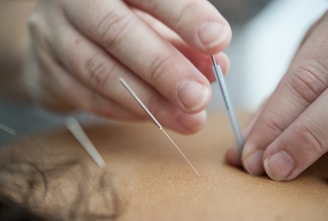Dry Needling
An effective treatment working deeper into the muscle to release the tension.






What is dry needling?
Dry needling involves the use of an acupuncture needle being inserted into a tight and restricted area of tension, also known as a trigger point or tension knot. It can be inserted into tight bands of fascia and scar tissue to help break down the restrictions.
We insert a needle or needles into these tight areas of restrictions and tension to help break down the tightness in the fibre, partly by increasing oxygen to the area and decreasing pain receptors.
Needles may be left for a few minutes or moved backwards and forwards through the muscle fibres to help decrease muscular tension.
How can it benefit me?
Dry needling is helpful in both acute and chronic situations. Teamed with massage therapy it creates a powerful combination where the massage helps break down the tension and needling is then used on areas which still have resistance and tightness.
It can help by breaking down tightness and restrictions in the muscles. Work on myofascial points to release tightness, not only in the muscle being needled but surrounding muscles.
Dry needling can help to increase mobility within a muscle, decrease pain issues, reduce tightness and restrictions and help break down adhesions.
Types of conditions used for.
Dry needling is especially affective in acute conditions as well as chronic areas of restriction and tension.
It works into problem areas such as;
Frozen shoulder
Shoulder pain/impingement
Deep neck tension
Headaches caused by muscular tension
Tension under the scapular
Bicep tendonitis
Piriformis syndrome and gluteal pain
Scar tissue
Acute conditions
Lower back related issues
Chronic tension & restrictions
Repetitive strain issues
Tennis elbow
Whiplash
Myofascial restrictions
Calf pain
Amongst many others.
How is the session carried out?
Whilst it is possible to book a dry needling session as a stand alone session, we prefer to combine it with a deep tissue remedial massage. This gives us the opportunity to loosen up muscles, see what still remains tight and work into those particular restricted areas in order to get the best release.
If taken with deep tissue massage (which we recommend) the massage is provided first to loosen up the muscles and restrictions and needles are used afterwards in the areas that are remaining tight and need further loosening.
Needling usually takes 30 minutes but is dependent on how many areas need needling/how much tension is in the body. When combined with deep tissue massage we carry out the needling for 30 minutes but this can be extended.
As mentioned, this can be taken as a stand alone treatment. After identifying the areas of restrictions needles are placed and left for several minutes or moved in and out the muscle to stimulate the muscle.


Please note.....
Appointments need to be booked one day in advance
Due to the busy nature of our therapy studio, sessions require a one day advance booking. You are welcome to get in touch and see if there are any last minute spaces but be prepared that most sessions require 1 days notice.
Cancellation Policy
There is a cancellation policy in place for sessions cancelled with less than 24 hours notice. This is 50% fee of the value of the booked treatment. This is due to the fact that someone else could have taken the session and our staff need to be reimbursed for the time they have set aside.